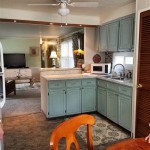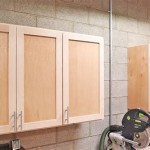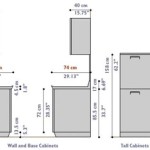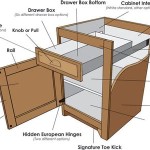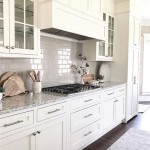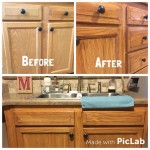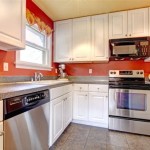How Much Do Kitchen Cabinets Cost? A Comprehensive Guide
Kitchen cabinets represent a substantial investment in any home renovation or new construction project. The cost can vary significantly depending on a range of factors, including the type of cabinets chosen, the materials used, the size of the kitchen, and the complexity of the installation. Understanding these factors is crucial for budgeting accurately and making informed decisions about kitchen design.
This article offers a comprehensive overview of the costs associated with kitchen cabinets, exploring different types of cabinets, materials, installation expenses, and strategies for potentially saving money. It aims to provide homeowners with the knowledge needed to navigate the often-complex process of selecting and purchasing kitchen cabinets.
Factors Influencing Kitchen Cabinet Costs
Several key factors contribute to the overall cost of kitchen cabinets. These range from the fundamental type of cabinetry selected to the finer details of hardware and finishes. Careful consideration of each factor is essential for staying within budget.
Cabinet Type: The type of cabinet construction significantly impacts the price. Cabinets are generally categorized into three main types: stock, semi-custom, and custom. Each type offers different levels of customization and, consequently, different price points.
Stock cabinets are pre-fabricated and readily available in standard sizes and styles. They represent the most affordable option, ideal for budget-conscious homeowners or those seeking a quick turnaround. However, stock cabinets offer limited customization options and may not perfectly fit all kitchen layouts.
Semi-custom cabinets offer a middle ground between stock and custom options. They are typically pre-made but allow for some modifications to size, style, and finish. This provides more flexibility than stock cabinets while remaining more budget-friendly than fully custom cabinets. Homeowners can often choose from a wider range of door styles, wood types, and finish options with semi-custom cabinets.
Custom cabinets are built to order, tailored to the specific dimensions and aesthetic preferences of the homeowner. They offer the highest level of customization, allowing for unique designs, unusual sizes, and personalized features. Custom cabinets are the most expensive option but provide the greatest opportunity to create a truly unique and functional kitchen space.
Materials: The materials used in cabinet construction also play a crucial role in determining the final cost. Different wood species, finishes, and hardware options can significantly impact the price. Various materials offer different levels of durability, aesthetics, and maintenance requirements.
Solid wood cabinets are considered a premium option, prized for their natural beauty, durability, and longevity. Popular wood choices include maple, oak, cherry, and walnut, each with its unique grain patterns and color variations. Solid wood cabinets are typically more expensive than cabinets made from engineered wood products.
Plywood is a common material for cabinet boxes, offering a balance of strength, stability, and affordability. It is less prone to warping or cracking compared to solid wood and provides a solid foundation for the cabinet structure.
Medium-density fiberboard (MDF) is an engineered wood product often used for cabinet doors and drawer fronts. It provides a smooth, consistent surface that is ideal for painting or applying a laminate finish. MDF is generally more affordable than solid wood or plywood.
Laminate cabinets feature a thin layer of decorative material bonded to a substrate, such as particleboard or MDF. They are a cost-effective option that offers a wide range of colors and patterns. Laminate cabinets are relatively easy to clean and maintain but may not be as durable as solid wood or plywood.
Kitchen Size and Layout: The size and layout of the kitchen directly impact the number of cabinets required, which in turn affects the overall cost. A larger kitchen with more wall space and a complex layout will naturally require more cabinets than a smaller, simpler kitchen.
The number of base cabinets, wall cabinets, and specialty cabinets (such as pantry cabinets or corner cabinets) will influence the total price. Complex layouts that require custom cabinet configurations or modifications may also increase the overall cost.
Installation Costs: Installation costs can represent a significant portion of the total cabinet expense. The complexity of the installation, the need for modifications, and the labor rates of the installer will all contribute to the final price.
Professional installation is highly recommended, especially for complex cabinet designs or custom installations. Experienced installers can ensure that the cabinets are properly aligned, leveled, and securely attached to the walls. Improper installation can lead to functional problems, aesthetic flaws, and even structural damage.
DIY installation can save money on labor costs, but it requires a high level of skill, experience, and attention to detail. Incorrect measurements, improper alignment, or inadequate support can result in costly mistakes and potential safety hazards. Homeowners considering DIY installation should carefully assess their skills and experience before undertaking the project.
Average Cost Ranges for Kitchen Cabinets
Providing precise cost estimates for kitchen cabinets is challenging due to the wide range of variables involved. However, general cost ranges can offer a helpful starting point for budgeting purposes. These figures are based on national averages and do not include installation costs, which should be factored in separately.
Stock Cabinets: Stock cabinets typically range from $70 to $200 per linear foot. This is the most affordable option, suitable for budget-conscious renovations or quick upgrades.
Semi-Custom Cabinets: Semi-custom cabinets generally range from $150 to $650 per linear foot. This provides a balance between affordability and customization, allowing for some modifications to fit specific kitchen layouts and design preferences.
Custom Cabinets: Custom cabinets can range from $600 to $1,500 or more per linear foot. This represents the most expensive option, offering unlimited customization and the highest level of craftsmanship.
The total cost of kitchen cabinets for an average-sized kitchen (approximately 10' x 12') can range from $4,000 to $20,000 or more, depending on the type of cabinets, materials, and installation costs. These figures are approximate and can vary significantly based on individual project requirements.
Strategies for Saving Money on Kitchen Cabinets
While kitchen cabinets represent a significant investment, several strategies can help homeowners save money without compromising quality or functionality. Careful planning, smart material choices, and strategic sourcing can all contribute to cost savings.
Consider Refacing Existing Cabinets: Refacing involves replacing the cabinet doors, drawer fronts, and hardware while keeping the existing cabinet boxes. This can be a cost-effective alternative to replacing the entire cabinet system, especially if the existing boxes are in good condition. Refacing can significantly update the look of the kitchen without the expense of a full cabinet replacement.
Explore Alternative Materials: Opting for engineered wood products, such as plywood or MDF, can save money compared to solid wood cabinets. These materials offer comparable strength and stability while being more affordable. Laminate finishes can also provide a cost-effective alternative to more expensive wood stains or paint finishes.
Shop Around and Compare Prices: Obtaining quotes from multiple cabinet suppliers and installers is essential for finding the best prices. Comparison shopping allows homeowners to assess different options, negotiate prices, and identify potential savings. Online retailers, local cabinet shops, and national home improvement stores can all offer competitive pricing.
Consider Open Shelving: Incorporating open shelving into the kitchen design can reduce the number of cabinets required, potentially lowering the overall cost. Open shelving provides a stylish and functional alternative to wall cabinets, allowing for easy access to frequently used items and displaying decorative elements.
Minimize Customization: Reducing the amount of customization can help control costs. Stick to standard cabinet sizes and configurations whenever possible. Avoiding complicated designs or unusual features can streamline the manufacturing process and reduce labor expenses.
Time the Purchase Strategically: Cabinet manufacturers and retailers often offer sales and promotions throughout the year. Taking advantage of these opportunities can significantly lower the cost of kitchen cabinets. Look for seasonal sales, clearance events, or special financing options.
DIY Certain Aspects of the Project: While professional installation is generally recommended, homeowners can potentially save money by handling certain aspects of the project themselves. This may include removing existing cabinets, painting cabinet boxes, or installing hardware. However, it's important to carefully assess skills and experience before undertaking any DIY tasks.
Ultimately, the cost of kitchen cabinets is a complex equation influenced by numerous factors. By carefully considering these factors, exploring different options, and implementing cost-saving strategies, homeowners can make informed decisions and create a beautiful and functional kitchen space that fits their budget and lifestyle.

What Is The Average Kitchen Cabinet Cost

How Much Do New Cabinets Cost Bkc Kitchen And Bath

What Does An Average Kitchen Cost Superior Cabinets

What Do Kitchen Cabinets Cost Tips To Stay In Budget

How Much Does A Kitchen Remodel Cost 2024

Average Cost To Replace Cabinets Forbes Home

Kitchen Installation Cost 2024 Data

What Is The Average Kitchen Cabinet Cost

Kitchen Cabinets Costs 2024 Data Angi

Ultimate Guide To Kitchen Remodel Cost Lily Ann Cabinets
Related Posts

